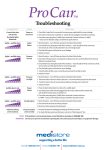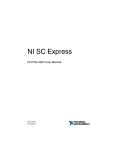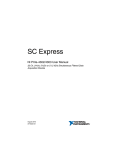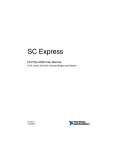Download 8-Slot NI PXIe-1082 Backplane Installation Guide
Transcript
INSTALLATION GUIDE 8-Slot NI PXIe-1082 Backplane This guide describes installation requirements for the 8-slot NI PXIe-1082 backplane. Contents NI PXIe-1082 Backplane Overview ....................................................... 2 Interoperability with CompactPCI................................................... 3 System Controller Slot..................................................................... 3 Hybrid Peripheral Slots.................................................................... 4 PXI Express Peripheral Slots ........................................................... 4 System Timing Slot ......................................................................... 4 PXI Local Bus.................................................................................. 6 PXI Trigger Bus............................................................................... 6 System Reference Clock .................................................................. 7 PXIe_SYNC_CTRL ........................................................................ 9 Mechanical Requirements....................................................................... 10 Mounting.......................................................................................... 10 Dimensions ...................................................................................... 11 Cooling............................................................................................. 11 Handling.................................................................................................. 12 Electrical Requirements .......................................................................... 13 PXI Connectors................................................................................ 13 Power ............................................................................................... 14 Connector J37 ........................................................................... 14 Connector J36 ........................................................................... 16 Connector J35 ........................................................................... 16 Connectors J2, J3, and J4.......................................................... 17 Backplane Specifications ................................................................. 17 System Synchronization Clock (PXI_CLK10, PXIe_CLK100, PXIe_SYNC100) Specifications................................................... 18 10 MHz System Reference Clock: PXI_CLK10 ...................... 18 100 MHz System Reference Clock: PXIe_CLK100 and PXIe_SYNC100 .................................................................... 18 External Clock Source .............................................................. 19 PXIe_SYNC_CTRL..................................................................19 PXI Differential Star Triggers (PXIe-DSTARA, PXIe-DSTARB, PXIe-DSTARC) ..........................................19 Pinouts .....................................................................................................20 System Controller Slot Pinouts ........................................................21 System Timing Slot Pinouts .............................................................22 Hybrid Slot Pinouts ..........................................................................23 NI PXIe-1082 Backplane Overview This section provides an overview of the backplane features for the NI PXIe-1082 chassis. Figure 1 shows the backplane. Figure 1. 8-Slot NI PXIe-1082 Backplane 8-Slot NI PXIe-1082 Backplane Installation Guide 2 ni.com Interoperability with CompactPCI With the NI PXIe-1082, you can use the following devices in a single PXI Express system: • PXI Express-compatible products • CompactPCI Express-compatible 4-Link system controller products • CompactPCI Express-compatible Type-2 peripheral products • Hybrid-compatible PXI peripheral products • Standard CompactPCI peripheral products Link #4 Link #3 Link #2 0 x4 Link #1 x4 0 PLX PEX8612 PCIe Switch 5 x4 1 1 x4 x4 0 PLX PEX8612 PCIe Switch x4 5 PLX PEX8616 PCIe Switch 1 5 x4 x4 6 x4 x4 PCIe/PCI Bridge H 1 2 3 4 5 H 6 H 7 H 8 Figure 2. NI PXIe-1082 Backplane Architecture System Controller Slot The system controller slot is Slot 1 of the chassis and is a 4-Link configuration system slot as defined by the CompactPCI Express and PXI Express specifications. It has three system controller expansion slots for system controller modules that are wider than one slot. These slots allow the system controller to expand to the left to prevent the system controller from using peripheral slots. The backplane routes the first x4 PCI Express link from the system slot directly to slot 2. The other three x4 PCI Express links each are routed from the system slot to a PCI Express switch. The three PCI Express switches have x4 PCI Express links routed to each remaining peripheral © National Instruments 3 8-Slot NI PXIe-1082 Backplane Installation Guide slot. One PCI Express switch also has a x1 PCI Express link routed to a PCI Express-to-PCI bridge that provides a 32-bit, 33 MHz PCI bus to the four hybrid slots. Refer to Figure 2 for the connectivity of PCI Express and PCI. By default, the system controller controls the power supply with the PS_ON# signals. A logic low on this line turns on the power supply. Hybrid Peripheral Slots The backplane includes four hybrid peripheral slots as defined by the PXI-5 PXI Express Hardware Specification: slots 5 to 8. A hybrid peripheral slot can accept the following peripheral modules: • A PXI Express peripheral with a x4 or x1 PCI Express link to the system slot or through a switch to the system slot. • A CompactPCI Express Type-2 peripheral with a x4 or x1 PCI Express link to the system slot or through a switch to the system slot. • A hybrid-compatible PXI peripheral module modified by replacing the J2 connector with an XJ4 connector installed in the upper eight rows of J2. Refer to the PXI Express Specification for details. The PXI peripheral communicates through the backplane 32-bit PCI bus. • A CompactPCI 32-bit peripheral on the backplane 32-bit PCI bus. The hybrid peripheral slots provide full PXI Express functionality and 32-bit PXI functionality except for PXI Local Bus. The hybrid peripheral slot connects only to PXI Local Bus 6 left and right. PXI Express Peripheral Slots There are two PXI Express peripheral slots: slots 2 and 3. PXI Express peripheral slots can accept the following modules: • A PXI Express peripheral with a x4 or x1 PCI Express link to the system slot or through a switch to the system slot. • A CompactPCI Express Type-2 peripheral with a x4 or x1 PCI Express link to the system slot or through a switch to the system slot. System Timing Slot The system timing slot is slot 4. The system timing slot accepts the following peripheral modules: • A PXI Express system timing module with a x4 or x1 PCI Express link to the system slot through a PCI Express switch. • A PXI Express peripheral with a x4 or x1 PCI Express link to the system slot through a PCI Express switch. • A CompactPCI Express Type-2 peripheral with a x4 or x1 PCI Express link to the system slot through a PCI Express switch. 8-Slot NI PXIe-1082 Backplane Installation Guide 4 ni.com The system timing slot has three dedicated differential pairs (PXIe_DSTAR) connected from the TP2 connector to the XP3 connector for each PXI Express peripheral or hybrid peripheral slot, as well as routed back to the XP3 connector of the system timing slot, as shown in Figure 3. You can use the PXIe_DSTAR pairs for high-speed triggering, synchronization, and clocking. Refer to the PXI Express Specification for details. The system timing slot also has a single-ended (PXI Star) trigger connected to every slot. Refer to Figure 3 for details. The system timing slot has a pin (PXI_CLK10_IN) through which a system timing module can source a 10 MHz clock to which the backplane phase-locks. Refer to the System Reference Clock section for details. The system timing slot has a pin (PXIe_SYNC_CTRL) through which a system timing module can control the PXIe_SYNC100 timing. Refer to the PXI Express Specification and the PXIe_SYNC_CTRL section for details. PXI_STAR2 PXI_STAR6 PXI_STAR5 PXI_STAR0 PXI_STAR4 2 3 4 5 H 6 PXIe_DSTAR11 PXIe_DSTAR9 PXIe_DSTAR8 H 1 PXIe_DSTAR10 PXI_STAR3 PXIe_DSTAR0 PXIe_DSTAR1 PXIe_DSTAR1 PXIe_DSTAR2 PXI_STAR1 H 7 H 8 Figure 3. PXIe_DSTAR and PXI Star Connectivity Diagram © National Instruments 5 8-Slot NI PXIe-1082 Backplane Installation Guide PXI Local Bus The PXI backplane local bus is a daisy-chained bus that connects each peripheral slot with adjacent peripheral slots to the left and right. The backplane routes PXI Local Bus 6 between adjacent PXI slots. The left local bus 6 from slot 1 is not routed anywhere, and the right local bus signal from slot 18 is not routed anywhere. Local bus signals may range from high-speed TTL signals to analog signals as high as 42 V. Initialization software uses the configuration information specific to each adjacent peripheral module to evaluate local bus compatibility. PXI Trigger Bus All slots on the same PXI bus segment share eight PXI trigger lines. You can use these trigger lines in a variety of ways. For example, you can use triggers to synchronize the operation of several different PXI peripheral modules. In other applications, one module in the system timing slot can control carefully timed sequences of operations performed on other modules in the system. Modules can pass triggers to one another, allowing precisely timed responses to asynchronous external events the system is monitoring or controlling. Figure 4 shows the PXI trigger bus connectivity. PXI Trigger Bus H 1 2 3 4 5 H 6 H 7 H 8 Figure 4. PXI Trigger Bus Connectivity Diagram 8-Slot NI PXIe-1082 Backplane Installation Guide 6 ni.com System Reference Clock The NI PXIe-1082 chassis supplies PXI_CLK10, PXIe_CLK100, and PXIe_SYNC100 to every peripheral slot with an independent driver for each signal. An independent buffer (having a source impedance matched to the backplane and a skew of less than 500 ps between slots) drives PXI_CLK10 to each peripheral slot. You can use this common reference clock signal to synchronize multiple modules in a measurement or control system. An independent buffer drives PXIe_CLK100 to each peripheral slot. These clocks are matched in skew to less than 100 ps. The differential pair must be terminated on the peripheral with LVPECL termination for the buffer to drive PXIe_CLK100 so that when there is no peripheral or a peripheral that does not connect to PXIe_CLK100, no clock is being driven on the pair to that slot. Refer to Figure 5 for a termination example. CLK100 + + CLK100 – – 50 Ω 50 Ω 47 Ω 0.01 μF Figure 5. CLK100 Termination An independent buffer drives PXIe_SYNC100 to each peripheral slot. The differential pair must be terminated on the peripheral with LVPECL termination for the buffer to drive PXIe_SYNC100 so that when there is no peripheral or a peripheral that does not connect to PXIe_SYNC100, no SYNC100 signal is being driven on the pair to that slot. Refer to Figure 5 for a termination example. In summary, PXI_CLK10 is driven to every slot. PXIE_CLK100 and PXIE_SYNC100 are driven to every peripheral slot. © National Instruments 7 8-Slot NI PXIe-1082 Backplane Installation Guide PXI_CLK10, PXIe_CLK100, and PXIe_SYNC100 have the default timing relationship described in Figure 6. 0 1 2 3 4 5 6 7 8 9 0 1 2 3 4 5 6 7 8 9 0 1 2 3 4 5 6 7 8 9 PXIe_CLK100 PXI_CLK10 PXIe_SYNC100 Figure 6. System Reference Clock Default Behavior To synchronize the system to an external clock, you can drive PXI_CLK10 from an external source through the PXI_CLK10_IN pin on the System Timing Slot. Refer to Table 10, XP4 Connector Pinout for the System Timing Slot, for the pinout. When a 10 MHz clock is detected on this pin, the backplane automatically phase-locks the PXI_CLK10, PXIe_CLK100, and PXIe_SYNC100 signals to this external clock and distributes these signals to the slots. Refer to the Backplane Specifications section for the specification information for an external clock provided on the PXI_CLK10_IN pin of the system timing slot. You also can drive a 10 MHz clock on connector J36. Refer to Figure 11 for the location of this connector. When a 10 MHz clock is detected on this connector, the backplane automatically phase-locks the PXI_CLK10, PXIe_CLK100, and PXIe_SYNC100 signals to this external clock and distributes these signals to the slots. Refer to the Backplane Specifications section for the specification information for an external clock provided on J36. If the 10 MHz clock is present on both the PXI_CLK10_IN pin of the System Timing Slot and connector J36, the signal on the System Timing Slot is selected. Refer to Table 1, which explains how the backplane selects the 10 MHz clocks. 8-Slot NI PXIe-1082 Backplane Installation Guide 8 ni.com Table 1. Backplane External Clock Input Truth Table System Timing Slot PXI_CLK10_IN J36 10 MHz REF IN Backplane PXI_CLK10, PXIe_CLK100 and PXIe_SYNC100 No clock present No clock present Backplane generates its own clocks No clock present 10 MHz clock present PXI_CLK10, PXIe_CLK100 and PXIe_SYNC100 all phase-locked to J36—10 MHz REF IN 10 MHz clock present No clock present PXI_CLK10, PXIe_CLK100 and PXIe_SYNC100 all phase-locked to System Timing Slot—PXI_CLK10_IN 10 MHz clock present 10 MHz clock present PXI_CLK10, PXIe_CLK100 and PXIe_SYNC100 all phase-locked to System Timing Slot—PXI_CLK10_IN A copy of the backplane’s PXI_CLK10 is exported to connector J36. Refer to Figure 11 for the location of this connector. An independent buffer drives this clock. Refer to the Backplane Specifications section for the specification information for the 10 MHz REF OUT signal on J36. PXIe_SYNC_CTRL PXIe_SYNC100 is by default a 10 ns pulse synchronous to PXI_CLK10. The frequency of PXIe_SYNC100 is 10/n MHz, where n is a positive integer. The default for n is 1, giving PXIe_SYNC100 a 100 ns period. However, the backplane allows n to be programmed to other integers. For example, setting n = 3 creates a PXIe_SYNC100 with a 300 ns period while still maintaining its phase relationship to PXI_CLK10. The n value can be any positive integer from 1 to 255. The system timing slot has a control pin for PXIe_SYNC100 called PXIe_SYNC_CTRL, for use when n > 1. Refer to Table 9, XP3 Connector Pinout for the System Timing Slot, for the system timing slot pinout. Refer to the Backplane Specifications section for the PXIe_SYNC_CTRL input specifications. By default, a high level detected by the backplane on the PXIe_SYNC_CTRL pin causes a synchronous restart for the PXIe_SYNC100 signal. On the next PXI_CLK10 edge, the PXIe_SYNC100 signal restarts. This allows several chassis to have their PXIe_SYNC100 in phase with each other. Refer to Figure 7 for timing details with this method. © National Instruments 9 8-Slot NI PXIe-1082 Backplane Installation Guide PXI_CLK10 PXIe_SYNC_CTRL PXIe_SYNC100 SYNC100 Divider Restarted Here Figure 7. PXIe_SYNC100 at 3.33 MHz Using PXIe_SYNC_CTRL as Restart Mechanical Requirements Mounting Figure 8 shows the backplane dimensions. There are 22 holes available for mounting with M2.5 hardware. Use all mounting holes for proper backplane support. Eight mounting holes on top of the backplane have plated annular pads on the back of the backplane. Use these mounting holes to connect the backplane ground to the chassis in which the backplane is mounted. If you do not want to connect the backplane ground to the chassis, use insulated washers at these mounting holes. Refer to Figure 11 for the mounting hole positions. 8-Slot NI PXIe-1082 Backplane Installation Guide 10 ni.com Dimensions 0.89 in. (22.61 mm) 0.125 in. (3.18 mm) 0.375 in. (9.53 mm) 5.933 in. (150.70 mm) 0.122 in. (3.10 mm) 0.824 in. (20.92 mm) 0.800 in. (20.32 mm) 9.843 in. (250 mm) Figure 8. Dimensions Cooling National Instruments is not responsible for damage to the backplane if inadequate cooling is used. Note Airflow should be from the bottom to the top of the PXI modules. You must determine the airflow requirements for your system based on the PXI Hardware Specification. The backplane must be adequately cooled to function reliably. Ensure that the components shown in Figure 9 are kept below their maximum case temperatures throughout the operating range. © National Instruments 11 8-Slot NI PXIe-1082 Backplane Installation Guide 2 1 9 8 7 1 2 3 4 5 5 6 U7—125.00 °C U12—125.00 °C U36—113.29 °C U46—113.29 °C U33—123.95 °C 4 3 6 7 8 9 U47—123.95 °C U42—124.40 °C U34—123.95 °C U31—112.49 °C Figure 9. Thermally Relevant Component Recommended Maximum Operating Case Temperature (°C) Handling Be careful to avoid bending or otherwise damaging the pins on the backplane connectors. Bent pins may cause functional failures or damage when the backplane is powered. Caution To protect both yourself and the backplane from electrical hazards, leave the chassis powered off until you finish installing the PXI controller and modules. Caution Electrostatic discharge can damage your equipment. To avoid such damage, discharge the static built up on your body by touching a grounded metal object before handling the PXI equipment. Then touch the antistatic plastic package containing the backplane to a metal part of your PXI chassis before removing the backplane from the packaging. Caution 8-Slot NI PXIe-1082 Backplane Installation Guide 12 ni.com Electrical Requirements PXI Connectors The PXI and PXI Express connectors have pin descriptions defined in the PXI Hardware Specification and PXI Express Hardware Specification. Figure 10 shows the connectors. 1 3 2 4 1 1 5 6 1 2 3 Card-Cage Thermistor Connectors (x3) Slot 1 (Controller Slot) PXI Express Peripheral Slots (2 to 3) 4 5 6 System Timing Slot (4) Hybrid Peripheral Slots (5 to 8) Power Button Connector Figure 10. PXI Connectors 1 2 1 Connector J36 2 Connector J37 Figure 11. Backplane Power and J36 Connectors © National Instruments 13 8-Slot NI PXIe-1082 Backplane Installation Guide Power Refer to the PXI Express Hardware Specification for power requirements and to the specifications of the chosen power supply to determine the minimum load required. Connector J37 Connector J37 is the NI PXIe-1082 backplane power supply connector. Figure 11 shows the J37 location. Refer to Table 2 for the pin descriptions. Connector J37 consists of eight #12 pins (1 to 4 and 26 to 29) for power. There also are 21 #20 pins (5 to 25) for mixed power and signaling. Table 2 also indicates which pins must be connected for basic backplane operation. Refer to the CompactPCI Express specification for details regarding PS_ON# and PS_OK. Do not use the voltage sense pins (22, 23, and 25) to power the board. These pins are connected by thin trace to the backplane center and are for voltage sensing only. Providing current through these pins may damage the backplane. If your power supply has voltage sensing, use these pins; otherwise, leave them unconnected. Pins with “power plane” in the description are connected to the backplane’s internal power planes and are suitable for carrying current. Caution Note Tyco Electronics manufactures the J37 mating connector, which you can order with part number 298-08-01100. The connector SMBus pins are connected to the backplane SMBus, which the CompactPCI Express specification defines. (The specification also defines uses and addressing.) Improper use of the SMBus could result in system controller malfunctions. Note There are three SMBus slave devices on the NI PXIe-1082 backplane. The Backplane Descriptor EEPROM is at slave address A4H as defined by the CompactPCI Express specification, and the backplane clocking CPLD is at slave address 5AH. There is a temperature monitoring device at slave address 5CH. If you must connect an SMBus slave device to the J37 SMBus pins, use slave address 58H. 8-Slot NI PXIe-1082 Backplane Installation Guide 14 ni.com Table 2. Connector J37 Pin Descriptions Connector © National Instruments Pin Signal Description Required for Basic Power Up 1 +3.3V +3.3 V power plane Yes 2 GND Ground plane Yes 3 +3.3V +3.3 V power plane Yes 4 GND Ground plane Yes 5 5VAUX 5VAUX power plane Yes 6 GND Ground plane Yes 7 -12V -12 V power plane Yes 8 GND Ground plane Yes 9 SMBCLK Backplane SMBus clock No 10 SMBDAT Backplane SMBus data No 11 SMBALERT# Backplane SMBus alert# No 12 PS_ON# From system slot J18—pin D2 No 13 PS_OK To system slot from power supply Yes 14 LED1 J35—pin 3 No 15 LED2 J35—pin 4 No 16 GND Ground plane Yes 17 -12V -12 V power plane Yes 18 GND Ground plane Yes 19 OVERTEMP# Alert of over-temperature condition in card cage No 20 12V_FAN To pin 7 of test header W1 No 21 GND Ground plane Yes 22 +12V_SENSE +12 V sense only, no power No 23 +3.3V_SENSE +3.3 V sense only, no power No 24 GND Ground plane Yes 25 +5V_SENSE +5 V sense only, no power No 26 +12V +12 V power plane Yes 27 GND Ground plane Yes 15 8-Slot NI PXIe-1082 Backplane Installation Guide Table 2. Connector J37 Pin Descriptions (Continued) Connector Pin Signal Description Required for Basic Power Up 28 +5V +5 V power plane Yes 29 GND Ground plane Yes Connector J36 Connector J36 is for interfacing with the backplane PXI_CLK10 circuitry. Figure 11 shows the J36 connector location. Positronic manufactures the J36 mating connector, which you can order with part number CBD7W2M2000Z-759.1. Ground Cable Shield 10 MHz OUT Cable Shield 10 MHz IN Figure 12. J36 Connector Connector J35 Use connector J35 in conjunction with J37 for interfacing with an inhibit switch and LED. You do not need to connect anything to J35 for basic backplane power up. Refer to Table 3 for the pin descriptions. The power button (PWRBTN#) signal is a momentary pushbutton signal that tells the system controller to enable or inhibit the power supply. You can use signals LED1 and LED2 to drive a bicolor LED in the power switch, but you also can use these signals to carry another digital signal. 8-Slot NI PXIe-1082 Backplane Installation Guide 16 ni.com Table 3. Connector J35 Pin Descriptions Connector J35 Pin Signal Description 1 PWRBTN# Input to system slot J18—pin F2 2 GND Ground plane 3 LED1 J37—pin 14 4 LED2 J37—pin 15 4 3 2 1 Connectors J2, J3, and J4 Use these connectors for three thermistors to monitor the card-cage temperature. You can use signal OVERTEMP# on J37 as an alarm indicating when the card-cage temperature exceeds 90 °C when used in conjunction with the four thermistors. Note Use a Sensor Scientific KWM502C-6 or similar thermistor with these connectors. Note The mating connector for J2, J3, and J4 is Molex part number 50-57-9402. Backplane Specifications Size......................................................... 3U-sized; one system slot (with three system expansion slots) and 7 peripheral slots. Compliant with IEEE 1101.10 mechanical packaging. PXI Express specification compliant. Accepts both PXI Express and CompactPCI (PICMG 2.0 R 3.0) 3U modules. Backplane bare-board material .............. UL 94 V-0 Recognized Backplane connectors ............................ Conforms to IEC 917 and IEC 1076-4-101, and are UL 94 V-0 rated © National Instruments 17 8-Slot NI PXIe-1082 Backplane Installation Guide System Synchronization Clock (PXI_CLK10, PXIe_CLK100, PXIe_SYNC100) Specifications 10 MHz System Reference Clock: PXI_CLK10 Maximum slot-to-slot skew ....................500 ps Accuracy .................................................±25 ppm max (guaranteed over the operating temperature range) Maximum jitter .......................................5 ps RMS phase-jitter (10 Hz to 1 MHz range) Duty-factor..............................................45% to 55% Unloaded signal swing............................3.3 V ±0.3 V Note For other specifications, refer to the PXI-1 Hardware Specification. 100 MHz System Reference Clock: PXIe_CLK100 and PXIe_SYNC100 Maximum slot-to-slot skew ....................100 ps Accuracy .................................................±25 ppm max (guaranteed over the operating temperature range) Maximum jitter .......................................3 ps RMS phase-jitter (10 Hz to 12 kHz range) 2 ps RMS phase-jitter (12 kHz to 20 MHz range) Duty-factor for PXIe_CLK100...............45% to 55% Absolute single-ended voltage swing (When each line in the differential pair has 50 Ω termination to 1.30 V or Thévenin equivalent)..........................400 to 1000 mV Note For other specifications, refer to the PXI-5 PXI Express Hardware Specification. External 10 MHz Reference Out (on J36) Accuracy .................................................±25 ppm max (guaranteed over the operating temperature range) Maximum jitter .......................................5 ps RMS phase-jitter (10 Hz to 1 MHz range) 8-Slot NI PXIe-1082 Backplane Installation Guide 18 ni.com Output amplitude.................................... 1 VPP ±20% square-wave into 50 Ω 2 VPP unloaded Output impedance .................................. 50 Ω ± 5 Ω External Clock Source Frequency............................................... 10 MHz ±100 PPM Input amplitude J36 ................................................... 200 mVPP to 5 VPP square-wave or sine-wave System timing slot PXI_CLK10_IN.............................. 5 V or 3.3 V TTL signal J36 input impedance............................... 50 Ω ± 5 Ω Maximum jitter introduced by backplane .......................................... 1 ps RMS phase-jitter (10 Hz to 1 MHz range) PXIe_SYNC_CTRL VIH .......................................................... 2.0 to 5.5 V VIL .......................................................... 0 to 0.8 V PXI Star Trigger Maximum slot-to-slot skew ................... 250 ps Backplane characteristic impedance ...... 65 Ω ±10% For PXI slot to PXI Star mapping, refer to the System Timing Slot section of Chapter 1, Getting Started, in the NI PXIe-1082 User Manual. Note Note For other specifications, refer to the PXI-1 Hardware Specification. PXI Differential Star Triggers (PXIe-DSTARA, PXIe-DSTARB, PXIe-DSTARC) Maximum slot-to-slot skew ................... 150 ps Maximum differential skew ................... 25 ps Backplane differential impedance.......... 100 Ω ±10% © National Instruments 19 8-Slot NI PXIe-1082 Backplane Installation Guide Note For PXI Express slot to PXI_DSTAR mapping, refer to the System Timing Slot section of Chapter 1, Getting Started, in the NI PXIe-1082 User Manual. For other specifications, the NI PXIe-1082 complies with the PXI-5 PXI Express Hardware Specification. Note Pinouts This section describes the connector pinouts for the NI PXIe-1082 chassis backplane. Table 4 shows the XP1 connector pinout for the System Controller slot. Table 5 shows the XP2 Connector Pinout for the System Controller slot. Table 6 shows the XP3 Connector Pinout for the System Controller slot. Table 7 shows the XP4 Connector Pinout for the System Controller slot. Table 8 shows the TP2 Connector Pinout for the System Timing slot. Table 9 shows the XP3 Connector Pinout for the System Timing slot. Table 10 shows the XP4 Connector Pinout for the System Timing slot. Table 11 shows the P1 connector pinout for the Hybrid peripheral slots. Table 12 shows the XP3 Connector Pinout for the Hybrid peripheral slots. Table 13 shows the XP4 Connector Pinout for the Hybrid peripheral slots. For more detailed information, refer to the PXI-5 PXI Express Hardware Specification, Revision 2.0. Contact the PXI Systems Alliance for a copy of the specification. 8-Slot NI PXIe-1082 Backplane Installation Guide 20 ni.com System Controller Slot Pinouts Table 4. XP1 Connector Pinout for the System Controller Slot Pins Signals A GND B 3.3V C 5V D GND E 12V F 12V G GND Table 5. XP2 Connector Pinout for the System Controller Slot Pin A B ab C D cd E F ef 1 3PETp1 3PETn1 GND 3PERp1 3PERn1 GND 3PETp2 3PETn2 GND 2 3PETp3 3PETn3 GND 3PERp3 3PERn3 GND 3PERp2 3PERn2 GND 3 4PETp0 4PETn0 GND 4PERp0 4PERn0 GND 4PETp1 4PETn1 GND 4 4PETp2 4PETn2 GND 4PERp2 4PERn2 GND 4PERp1 4PERn1 GND 5 4PETp3 4PETn3 GND 4PERp3 4PERn3 GND RSV RSV GND 6 RSV RSV GND RSV RSV GND RSV RSV GND 7 RSV RSV GND RSV RSV GND RSV RSV GND 8 RSV RSV GND RSV RSV GND RSV RSV GND 9 RSV RSV GND RSV RSV GND RSV RSV GND 10 RSV RSV GND RSV RSV GND RSV RSV GND Table 6. XP3 Connector Pinout for the System Controller Slot Pin A B ab C D cd E F ef 1 RSV RSV GND RSV RSV GND RSV RSV GND 2 RSV RSV GND PWR_OK PS_ON# GND LINKCAP PWRBTN# GND 3 SMBDAT SMBCLK GND 4RefClk+ 4RefClk- GND 2RefClk+ 2RefClk- GND 4 RSV PERST# GND 3RefClk+ 3RefClk- GND 1RefClk+ 1RefClk- GND © National Instruments 21 8-Slot NI PXIe-1082 Backplane Installation Guide Table 6. XP3 Connector Pinout for the System Controller Slot (Continued) Pin A B ab C D cd E F ef 5 1PETp0 1PETn0 GND 1PERp0 1PERn0 GND 1PETp1 1PETn1 GND 6 1PETp2 1PETn2 GND 1PERp2 1PERn2 GND 1PERp1 1PERn1 GND 7 1PETp3 1PETn3 GND 1PERp3 1PERn3 GND 2PETp0 2PETn0 GND 8 2PETp1 2PETn1 GND 2PERp1 2PERn1 GND 2PERp0 2PERn0 GND 9 2PETp2 2PETn2 GND 2PERp2 2PERn2 GND 2PETp3 2PETn3 GND 10 3PETp0 3PETn0 GND 3PERp0 3PERn0 GND 2PERp3 2PERn3 GND Table 7. XP4 Connector Pinout for the System Controller Slot Pin Z A B C D E F 1 GND GA4 GA3 GA2 GA1 GA0 GND 2 GND 5Vaux GND SYSEN# WAKE# ALERT# GND 3 GND RSV RSV RSV RSV RSV GND 4 GND RSV RSV RSV RSV RSV GND 5 GND PXI_TRIG3 PXI_TRIG4 PXI_TRIG5 GND PXI_TRIG6 GND 6 GND PXI_TRIG2 GND RSV PXI_STAR PXI_CLK10 GND 7 GND PXI_TRIG1 PXI_TRIG0 RSV GND PXI_TRIG7 GND 8 GND RSV GND RSV RSV PXI_LBR6 GND System Timing Slot Pinouts Table 8. TP2 Connector Pinout for the System Timing Slot A B C D 1 Pin PXIe_DSTARC0+ PXIe_DSTARC0- GND ab PXIe_DSTARC8+ PXIe_DSTARC8- GND PXIe_DSTARB8+ PXIe_DSTARB8- GND 2 PXIe_DSTARA0+ PXIe_DSTARA0- GND PXIe_DSTARC9+ PXIe_DSTARC9- GND PXIe_DSTARA8+ PXIe_DSTARA8- GND 3 PXIe_DSTARB0+ PXIe_DSTARB0- GND PXIe_DSTARC1+ PXIe_DSTARC1- GND PXIe_DSTARA9+ PXIe_DSTARA9- GND 4 PXIe_DSTARB1+ PXIe_DSTARB1- GND PXI_STAR0 PXI_STAR1 GND PXIe_DSTARB9+ PXIe_DSTARB9- GND 5 PXIe_DSTARA1+ PXIe_DSTARA1- GND PXI_STAR2 PXI_STAR3 GND PXIe_DSTARC10+ PXIe_DSTARC10- GND 6 PXIe_DSTARC2+ PXIe_DSTARC2- GND PXI_STAR4 PXI_STAR5 GND PXIe_DSTARA10+ PXIe_DSTARA10- GND 7 PXIe_DSTARB2+ PXIe_DSTARB2- GND PXI_STAR6 NC GND PXIe_DSTARB10+ PXIe_DSTARB10- GND 8 PXIe_DSTARA2+ PXIe_DSTARA2- GND NC NC GND PXIe_DSTARC11+ PXIe_DSTARC11- GND 9 NC NC GND NC NC GND PXIe_DSTARA11+ PXIe_DSTARA11- GND 10 NC NC GND NC NC GND PXIe_DSTARB11+ PXIe_DSTARB11- GND 8-Slot NI PXIe-1082 Backplane Installation Guide 22 cd E F ef ni.com Table 9. XP3 Connector Pinout for the System Timing Slot Pin A B ab C D cd E F ef 1 PXIe_CLK100+ PXIe_CLK100- GND PXIe_SYNC100+ PXIe_SYNC100- GND PXIe_DSTARC+ PXIe_DSTARC- GND 2 PRSNT# PWREN# GND PXIe_DSTARB+ PXIe_DSTARB- GND PXIe_DSTARA+ PXIe_DSTARA- GND 3 SMBDAT SMBCLK GND RSV RSV GND RSV RSV GND 4 MPWRGD* PERST# GND RSV RSV GND 1RefClk+ 1RefClk- GND 5 1PETp0 1PETn0 GND 1PERp0 1PERn0 GND 1PETp1 1PETn1 GND 6 1PETp2 1PETn2 GND 1PERp2 1PERn2 GND 1PERp1 1PERn1 GND 7 1PETp3 1PETn3 GND 1PERp3 1PERn3 GND 1PETp4 1PETn4 GND 8 1PETp5 1PETn5 GND 1PERp5 1PERn5 GND 1PERp4 1PERn4 GND 9 1PETp6 1PETn6 GND 1PERp6 1PERn6 GND 1PETp7 1PETn7 GND 10 RSV RSV GND RSV RSV GND 1PERp7 1PERn7 GND Table 10. XP4 Connector Pinout for the System Timing Slot Pin Z A B C D E F 1 GND GA4 GA3 GA2 GA1 GA0 GND 2 GND 5Vaux GND SYSEN# WAKE# ALERT# GND 3 GND 12V 12V GND GND GND GND 4 GND GND GND 3.3V 3.3V 3.3V GND 5 GND PXI_TRIG3 PXI_TRIG4 PXI_TRIG5 GND PXI_TRIG6 GND 6 GND PXI_TRIG2 GND ATNLED PXI_CLK10_IN PXI_CLK10 GND 7 GND PXI_TRIG1 PXI_TRIG0 ATNSW# GND PXI_TRIG7 GND 8 GND PXIe_SYNC_CTRL GND RSV PXI_LBL6 PXI_LBR6 GND Hybrid Slot Pinouts Table 11. P1 Connector Pinout for the Hybrid Slot Pin Z A B C D E F 25 GND 5V REQ64# ENUM# 3.3V 5V GND 24 GND AD[1] 5V V(I/O) AD[0] ACK64# GND 23 GND 3.3V AD[4] AD[3] 5V AD[2] GND 22 GND AD[7] GND 3.3V AD[6] AD[5] GND 21 GND 3.3V AD[9] AD[8] M66EN C/BE[0]# GND 20 GND AD[12] GND V(I/O) AD[11] AD[10] GND 19 GND 3.3V AD[15] AD[14] GND AD[13] GND © National Instruments 23 8-Slot NI PXIe-1082 Backplane Installation Guide Table 11. P1 Connector Pinout for the Hybrid Slot (Continued) Pin Z A B C D E F 18 GND SERR# GND 3.3V PAR C/BE[1]# GND 17 GND 3.3V IPMB_SCL IPMB_SDA GND PERR# GND 16 GND DEVSEL# GND V(I/O) STOP# LOCK# GND 15 GND 3.3V FRAME# IRDY# BD_SEL# TRDY# GND 12 to 14 Key Area 11 GND AD[18] AD[17] AD[16] GND C/BE[2]# GND 10 GND AD[21] GND 3.3V AD[20] AD[19] GND 9 GND C/BE[3]# IDSEL AD[23] GND AD[22] GND 8 GND AD[26] GND V(I/O) AD[25] AD[24] GND 7 GND AD[30] AD[29] AD[28] GND AD[27] GND 6 GND REQ# GND 3.3V CLK AD[31] GND 5 GND BRSVP1A5 BRSVP1B5 RST# GND GNT# GND 4 GND IPMB_PWR HEALTHY# V(I/O) INTP INTS GND 3 GND INTA# INTB# INTC# 5V INTD# GND 2 GND TCK 5V TMS TDO TDI GND 1 GND 5V -12V TRST# +12V 5V GND Table 12. XP3 Connector Pinout for the Hybrid Slot Pin A B ab C D cd 1 PXIe_CLK100+ PXIe_CLK100- GND PXIe_SYNC100+ PXIe_SYNC100- GND 2 PRSNT# PWREN# GND PXIe_DSTARB+ PXIe_DSTARB- GND 3 SMBDAT SMBCLK GND RSV RSV GND 4 MPWRGD* PERST# GND RSV RSV GND 5 1PETp0 1PETn0 GND 1PERp0 1PERn0 GND 6 1PETp2 1PETn2 GND 1PERp2 1PERn2 GND 7 1PETp3 1PETn3 GND 1PERp3 1PERn3 GND 8 1PETp5 1PETn5 GND 1PERp5 1PERn5 GND 9 1PETp6 1PETn6 GND 1PERp6 1PERn6 GND 10 RSV RSV GND RSV RSV GND 8-Slot NI PXIe-1082 Backplane Installation Guide 24 E F ef PXIe_DSTARC+ PXIe_DSTARC- GND PXIe_DSTARA+ PXIe_DSTARA- GND RSV RSV GND 1RefClk+ 1RefClk- GND 1PETp1 1PETn1 GND 1PERp1 1PERn1 GND 1PETp4 1PETn4 GND 1PERp4 1PERn4 GND 1PETp7 1PETn7 GND 1PERp7 1PERn7 GND ni.com Table 13. XP4 Connector Pinout for the Hybrid Slot Pin Z A B C D E F 1 GND GA4 GA3 GA2 GA1 GA0 GND 2 GND 5Vaux GND SYSEN# WAKE# ALERT# GND 3 GND 12V 12V GND GND GND GND 4 GND GND GND 3.3V 3.3V 3.3V GND 5 GND PXI_TRIG3 PXI_TRIG4 PXI_TRIG5 GND PXI_TRIG6 GND 6 GND PXI_TRIG2 GND ATNLED PXI_STAR PXI_CLK10 GND 7 GND PXI_TRIG1 PXI_TRIG0 ATNSW# GND PXI_TRIG7 GND 8 GND RSV GND RSV PXI_LBL6 PXI_LBR6 GND © National Instruments 25 8-Slot NI PXIe-1082 Backplane Installation Guide Refer to the NI Trademarks and Logo Guidelines at ni.com/trademarks for more information on National Instruments trademarks. Other product and company names mentioned herein are trademarks or trade names of their respective companies. For patents covering National Instruments products/ technology, refer to the appropriate location: Help»Patents in your software, the patents.txt file on your media, or the National Instruments Patent Notice at ni.com/patents. You can find information about end-user license agreements (EULAs) and third-party legal notices in the readme file for your NI product. Refer to the Export Compliance Information at ni.com/legal/ export-compliance for the National Instruments global trade compliance policy and how to obtain relevant HTS codes, ECCNs, and other import/export data. © 2010–2013 National Instruments. All rights reserved. 373001B-01 Feb13











































